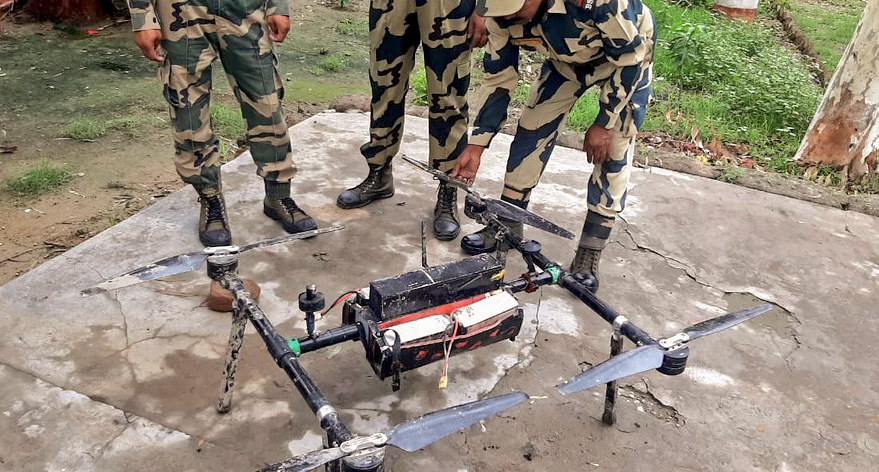India’s Border Security Challenge: Rogue Drones and Smuggling Surge

India is facing a significant security threat along its western border, particularly in Punjab, where rogue drones are increasingly used for smuggling narcotics, arms, and ammunition. This year has witnessed a sharp surge in drone-related incidents, highlighting the escalating challenge for security agencies combating illicit trafficking facilitated by unmanned aerial vehicles (UAVs). The rapid advancement and widespread adoption of drone technology pose a severe threat to India’s national security, with these incidents often tied to drug cartels or anti-national elements operating along the border. Criminal networks exploit the stealth capabilities of drones to evade traditional security measures, showcasing the adaptability of transnational criminal networks in leveraging technological advancements.

Law enforcement agencies are grappling with complex challenges in monitoring and intercepting unauthorized drone movements, necessitating enhanced surveillance and detection technologies to counter the evolving threat. The prevalence of drone-based smuggling underscores the urgent need for proactive measures to safeguard India’s borders and curb the proliferation of illicit activities facilitated by drones.
Emergence of Drone Smuggling
As far back as 2018, analysts had already noted the possibility of Pakistan-based drug cartels using drones on the India-Pakistan border in a similar pattern to the US-Mexico border. However, according to the Punjab government, the first recorded drone delivery of arms and ammunition was in August 2019. Since then, criminal networks have leveraged the stealth capabilities of drones to manoeuvre undetected, evading traditional security measures. This underscores the adaptability of transnational criminal networks and their exploitation of technological advancements.
(Read More: Webinar on “Humanitarian Issues in Border Security: Balancing Safety and Human Rights”)
Complex Challenges for Law Enforcement
Law enforcement agencies tasked with border security have been confronted with complex challenges posed by the sophistication of drone operations. Efforts to monitor and intercept unauthorized drone movements have seen limited success, prompting a need for enhanced surveillance and detection technologies.
(Read More: China Escalates Border Tensions with Civil-Military Fusion and Dual-Use Villages Along Disputed LAC)
Shifting to an Offensive Approach
Addressing this evolving security challenge requires a strategic shift from a defensive to an offensive approach. India must leverage drone technology not only for defensive surveillance but also for proactive offensive operations. This includes utilizing drones for surveillance, patrol, and domination of border areas to disrupt smuggling activities and enhance overall border security.
The Role of Border Patrol Drones
The evolution and widespread adoption of border patrol drones globally signify a significant advancement in modern border security strategies. Originating in the early 2000s with models like the Predator B, drone technology has revolutionized surveillance efforts along international borders.
Technological Advancements
Between 2018 and 2024, significant customization and advancements in drone technology have occurred. UAVs have been adapted to endure diverse environmental conditions, enhance payload capacity, and improve real-time data transmission. These enhancements have made drones indispensable tools for border security.
Leveraging Drones for Offensive Border Operations
Drones offer operational benefits by enabling rapid coverage of vast and challenging terrains, facilitating swift response times, and enhancing border monitoring capabilities. Equipped with advanced sensors and high-resolution cameras, they provide real-time data crucial for tracking criminal activities such as drug trafficking and human smuggling. India must capitalize on these technological advancements by deploying drones for offensive operations along its borders. By adopting an offensive approach, drones can effectively dominate and patrol border areas, proactively disrupting smuggling activities.
Expanded Role Beyond Surveillance
The versatility of drones extends beyond traditional surveillance tasks to encompass search and rescue operations, environmental monitoring, infrastructure inspections, and incident response. Advanced features like facial recognition and communication relay technology further enhance border security efforts.
Transitioning from Old Resources to New Drone Units
One significant strategy involves converting some old artillery units into drone units, leveraging their existing infrastructure and expertise to enhance surveillance and response capabilities. The transition from artillery units to drone units represents a strategic shift towards harnessing advanced technology for border security. Drones offer rapid coverage of vast and challenging terrains, enabling swift responses to potential threats while minimizing risks to personnel. By repurposing artillery units, India can maximize operational efficiency and adaptability in combating illicit activities facilitated by unmanned aerial vehicles (UAVs).
Traditional patrol units, such as those utilizing horses or camels, face limitations in navigating rugged terrains and may be susceptible to stealthy incursions facilitated by drones. Integrating drones into these units enhances their mobility, effectiveness, and situational awareness, empowering border patrols to detect and deter criminal activities more efficiently. The adoption of drone technology represents a proactive response to the evolving security landscape, enabling security agencies to stay ahead of transnational criminal networks exploiting technological advancements.
Conclusion: Strengthening Border Security
India’s adoption of offensive drone tactics represents a strategic shift towards proactive border security measures. Leveraging drone technology for offensive operations will bolster border surveillance capabilities and serve as a deterrent against illicit activities, ultimately safeguarding India’s territorial integrity and national security. In summary, the evolving threat posed by rogue drones underscores the critical need for innovative border security strategies. India’s transition to offensive drone tactics reflects a proactive response to combat smuggling activities and enhance overall border security in the face of persistent challenges.



Leave a Reply